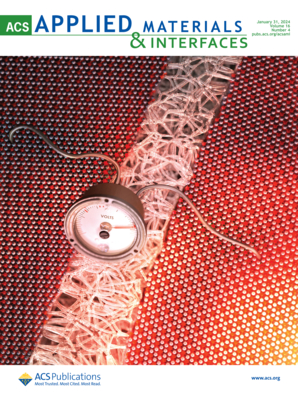通过蒸发CuSCN实现蒸发自组装传输层的可伸缩修改
IF 8.3
2区 材料科学
Q1 MATERIALS SCIENCE, MULTIDISCIPLINARY
引用次数: 0
摘要
溶液法制备的[4-(3,6-二甲基- 9h -咔唑-9-基)丁基]膦酸(Me-4PACz)自组装单层膜(SAM)作为一种优良的空穴传输材料广泛应用于高性能倒钙钛矿太阳能电池(PSCs)中。虽然真空蒸发Me-4PACz为大规模PSC制造提供了巨大的潜力,但蒸发的SAM润湿性差阻碍了其应用,这对器件性能产生了不利影响。本文采用蒸发硫氰酸亚铜(CuSCN)薄膜对蒸发Me-4PACz进行改性,改善了其润湿性,提高了钙钛矿薄膜的覆盖度和均匀性。此外,CuSCN的加入在sam -钙钛矿界面处建立了能级梯度,促进了高效的空穴传输。此外,CuSCN层有助于界面钝化,有效降低界面复合损失。结果表明,单结宽禁带PSCs (1.68 eV)的效率为21.62%。此外,蒸发制备的薄膜在大面积衬底上具有良好的均匀性,为大面积PSCs的制备奠定了基础。本文章由计算机程序翻译,如有差异,请以英文原文为准。

Scalable Modification of an Evaporated Self-Assembled Transport Layer through Evaporated CuSCN
The [4-(3,6-dimethyl-9H-carbazol-9-yl)butyl]phosphonic acid (Me-4PACz) self-assembled monolayer (SAM) deposited by solution processing has been widely used as an excellent hole-transporting material in high-performance inverted perovskite solar cells (PSCs). While vacuum-based evaporation of Me-4PACz offers significant potential for large-scale PSC fabrication, its application is hindered by the poor wettability of the evaporated SAM, which adversely affects the device performance. In this work, an evaporated cuprous thiocyanate (CuSCN) film was employed to modify the evaporated Me-4PACz, which can improve the wettability, leading to enhanced coverage and uniformity of the perovskite film. In addition, the incorporation of CuSCN established an energy level gradient at the SAM–perovskite interface, facilitating efficient hole transport. Moreover, the CuSCN layer contributed to interface passivation, effectively reducing interface recombination losses. As a result, an efficiency of 21.62% for single-junction wide-bandgap PSCs (1.68 eV) was achieved. Additionally, the films fabricated by evaporation show good uniformity on a large-area substrate, laying a foundation for large-area PSCs.
求助全文
通过发布文献求助,成功后即可免费获取论文全文。
去求助
来源期刊

ACS Applied Materials & Interfaces
工程技术-材料科学:综合
CiteScore
16.00
自引率
6.30%
发文量
4978
审稿时长
1.8 months
期刊介绍:
ACS Applied Materials & Interfaces is a leading interdisciplinary journal that brings together chemists, engineers, physicists, and biologists to explore the development and utilization of newly-discovered materials and interfacial processes for specific applications. Our journal has experienced remarkable growth since its establishment in 2009, both in terms of the number of articles published and the impact of the research showcased. We are proud to foster a truly global community, with the majority of published articles originating from outside the United States, reflecting the rapid growth of applied research worldwide.
 求助内容:
求助内容: 应助结果提醒方式:
应助结果提醒方式:


